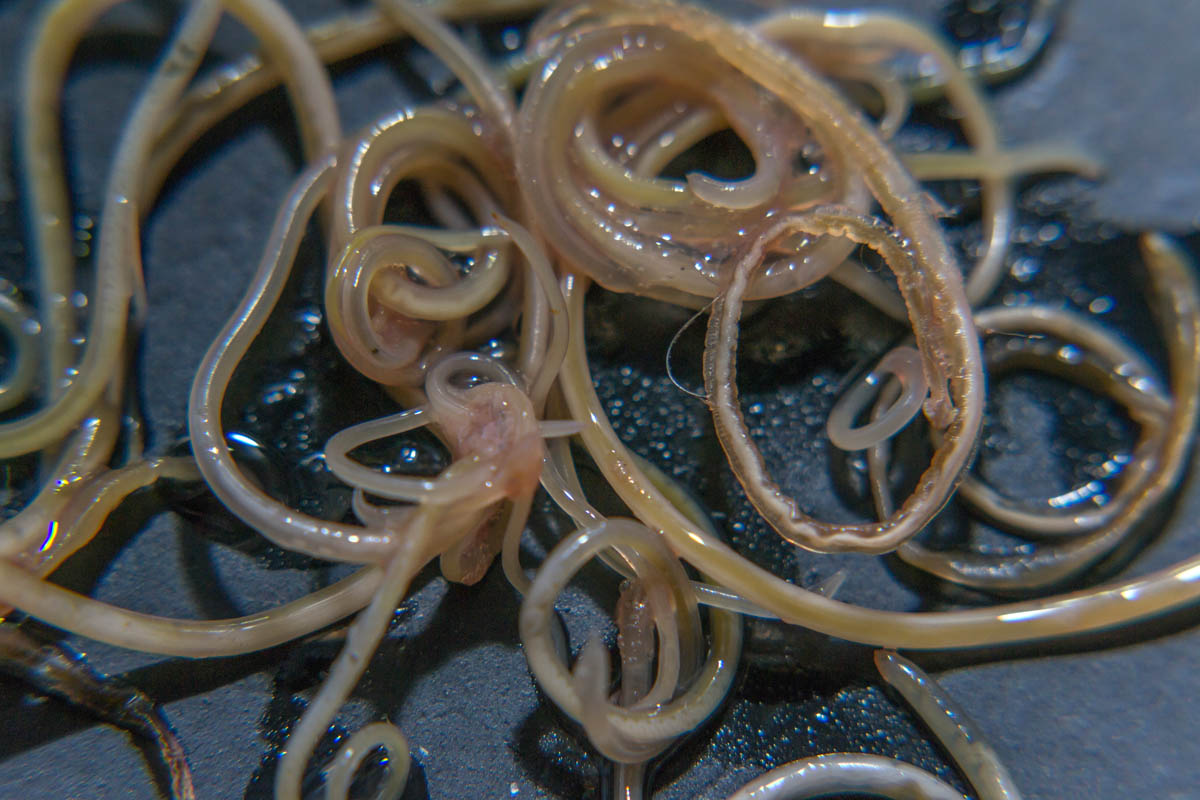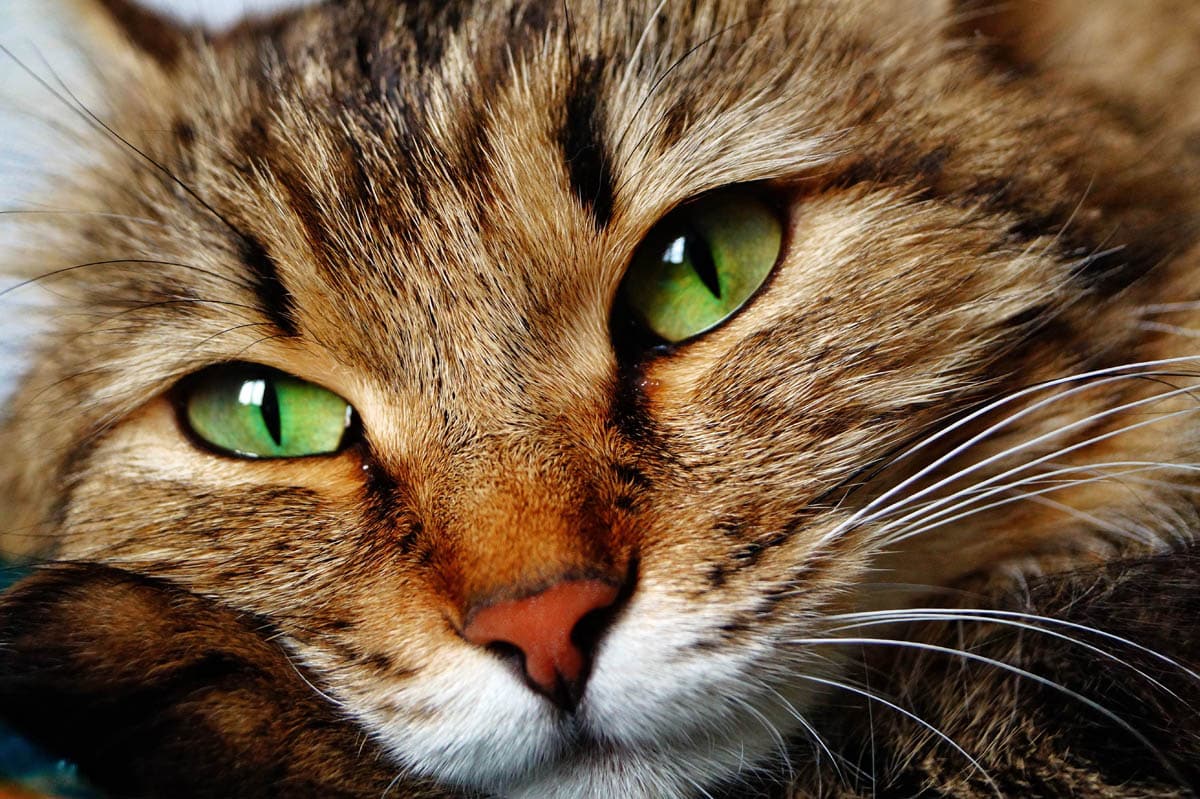Can indoor cats get worms?
Yes, even indoor cats can become infected with several types of parasitic worm. The risk of infection is lower by keeping a cat indoors; it is still possible for infection to occur in several ways which are outlined below.
How do indoor cats get worms?
Parasitic worms have evolved to be opportunistic, and there are several ways in which they can infect cats, even those who are strictly indoor cats.
Roundworm:

Two species of roundworm infect cats. T. Cati and T. Leonina.
T. Cati
When a cat becomes infected with roundworm eggs, larvae (immature roundworms) hatch and some migrate through the tissues where they form a cyst and lie undetected in a dormant state and immune to worming products. During pregnancy, dormant cysts are reactivated and migrate to the mammary glands where they go on to infect kittens when they nurse from their mother (lactogenic transmission).
T. Cati and T. Leonina
- Intermediate hosts: Adult roundworms produce eggs that pass out of the cat via the feces where it continues to develop in the environment into infective L2 stage.
- Rodents can become accidental (paratenic) hosts if they ingest roundworm eggs in the environment. Roundworms are unable to complete their life cycle in the rodent; however, they can migrate to the tissues where they encyst and become dormant. If the cat ingests the rodent containing cysts, an infection can occur. Most homes are thankfully rodent-free, but a rat or mouse can enter a home and infect a cat if it hunts and ingests the rodent.
- Cockroaches who eat T. Canis roundworm eggs in the environment can excrete them, still infective, via the feces over a 1 to 2 day period, which means that cockroaches can transport them into the home where they are shed via the feces, which a cat can come into contact with. The infective larvae of T. Cati can also remain in the tissues of cockroaches, which can then infect a cat that consumes the cockroach.
Hookworms:

Hookworms are small, thin nematodes that are approximately 10 to 20 mm in length and are a common intestinal parasitic worm of dogs but can also infect cats.
They live in the duodenum, the first part of the small intestine, where they attach themselves to the mucous membrane using teeth-like hooks to feed on the blood. Worms change their point of attachment every 4-6 hours, which causes the area to bleed. Blood loss can lead to anemia, intestinal bleeding, intestinal inflammation, diarrhea, and even death.
Adult hookworms produce eggs that are shed via feces. Once in the environment, eggs hatch into infective larvae after 2-5 days.
As infective hookworm larvae are in the environment, it is possible to track them into the home on our shoes. Infection can occur if the cat inhales or ingests the larvae (from the coat), or via skin penetration.
Transmission this way is uncommon, but it may be possible.
Tapeworms:

Also known as cestodes, tapeworms are flat, segmented worms that live in the small intestine of cats and other mammals.
Tapeworms have no mouth or digestive tract themselves and must obtain their food source pre-digested, they have a tough outer skin that is capable of withstanding the strong digestive juices. Tapeworms absorb the cat’s pre-disgested food through their porous skin.
There are approximately 5,000 species of tapeworm in the world, each of which has a specific host, only a small number of tapeworms infect cats.
The two most common tapeworms found in cats are dipylidium caninum and taenia taeniaeformis. The distribution of both dipylidium caninum and taenia taeniaeformis is worldwide. Both species live in the cat for up to three years.
Dipylidium caninum is transmitted via the bite of a flea infected with larval tapeworm. Infection occurs in the flea during the larval stage when the flea feeds on organic debris (mostly adult flea feces and flea eggs, but they will eat other parasitic eggs in the environment).
Once inside the flea larvae, the tapeworm larvae migrate to the body cavity where it remains during the larval transformation into an adult flea.
If a cat infected with fleas accidentally ingests an infected flea when it grooms, the flea breaks down to release the immature tapeworm.
Indoor cats can become infected with fleas which may hitch a ride on a person or other pet, or if pupae are in the house which becomes activated by the heat or carbon dioxide of a passing animal (cat or dog). A flea infestation is not a reflection of poor hygiene; any cat or household can have fleas.
Taenia taeniaeformis is less common in cats. Transmission occurs when a cat ingests a rodent infected with larval tapeworm.
Obviously, most households are rodent-free, but if a rodent does enter the home, and the cat eats it (our 16-year-old Burmese once caught and killed a mouse in the home), infection is possible.
Heartworm:

Dirofilariasis or heartworm is a serious parasitic infection caused by the nematode Dirofilaria immitis which lives in the pulmonary arteries, lungs, and hearts of cats. Heartworms are a type of roundworm, with adult heartworms reaching a length of 12 to 30 cm.
Infection occurs via the mosquito who passes on the microfilaria (baby heartworms) when they feed on the cat. Due to their size, mosquitoes can easily enter the home through holes in screen netting, open windows or doors, or even on a human when they enter the house.
Other possible modes of transmission:
Insects:
Moths, spiders and flies can be transport hosts for worms. There is very little information regarding the risks, but anything that can transport an egg from one location to another is a possible source.
Flies, moths, and spiders all have hair on their bodies (predominantly legs) for the eggs to stick to. As flies feed on feces, it stands to reason that they are of particular risk, the risk of infection from spiders or moths would be negligible.
Can cats get worms from raw meat?
It is unlikely that a cat fed a diet of HUMAN GRADE raw beef, lamb or chicken will develop intestinal parasites. Most worms are host specific or transport host-specific. Also, the processing of meat for human consumption is of a much higher standard than meat for pets. This is why I only recommend human-grade meat for cats.
If you are at all concerned about parasites in raw meat, freeze it for at least 24 hours before you give it to your cat.
Prevention:
There is no way to completely prevent parasitic worms in cats; we can, however, reduce the chances.
Cat:
- Worm indoor cats at least twice a year.
- Request a fecal examination once a year when you take the cat for its annual health check.
- Diligent flea control, not only on the cat but also in the home as 90% of the flea life cycle, is spent OFF the cat.
Home and garden:
- Remove stools from cat litter trays once a day before eggs become infective. Dispose of in the garbage bin and not the garden.
- Use fly screens on windows and doors and check for holes, which may let insects in.
- Don’t leave food lying around, which will attract flies.
- Hire a pest controller to spray the house once a year to reduce insect numbers in and around the home.
- Mosquitoes breed in standing water so don’t leave sources of water around the house such as plant trays, old tyres, buckets, and disused ponds or paddling pools.
How do I know if my cat has worms?
Most cats will remain asymptomatic unless they have a heavy worm burden. A definitive diagnosis can be made via a fecal flotation for intestinal worms or a blood test for heartworm.
Symptoms can include:

